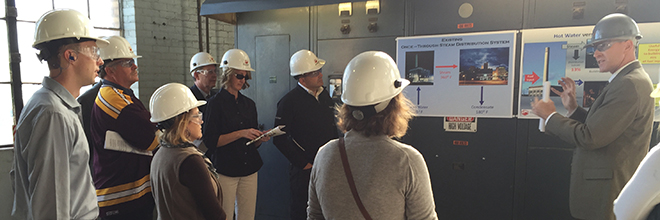System Transformation & Continuous Improvements
Duluth Energy System 5-Year Plan
The Duluth Energy System 5-Year Plan Update provides an overview of the achievements and outcomes from the energy system transformation while outlining options for continuous improvements, service enhancements, and strategic investments. This plan is informed by City of Duluth’s climate goals, outlining opportunities to reduce carbon while continuing to prioritize service reliability and cost.
Far Superior: Serious efficiency gains in Duluth business and hospital corridors
The Superior Street project included significant work in the street, at the plant, and in customer buildings. This transformational project has delivered system improvements and carbon reductions that meet the City of Duluth’s long-term vision for climate-resilience and cost effectiveness. Former general manager, Terry Nanti, and senior program manager, Sean McFarling, discussed project details and outcomes in a December 2020 Ever-Green Energy blog post.
Closing the Loop – Steam to Hot Water Transition
The City of Duluth leveraged the major investment of Superior Street reconstruction to modernize its energy system, upgrading from steam to hot water distribution. Hot water is a more efficient way to deliver energy to customers. Additionally, energy in a closed distribution loop can return to the plant in a cycle to get reheated and sent back out to customers. This saves energy and water.
Providing reliable, cost-competitive service is essential to Duluth Energy Systems, and the system transformation has improved operations through reduced fuel input, carbon emissions, chemical treatment, and water use. Hot water customers have seen reduced energy consumption in their buildings. Updating this energy infrastructure provides Duluth the pathway to a modern, resilient system while positioning it for the integration of renewable energy in the future.
Customer Benefits of Hot Water Services
- Upgrade to building equipment improves building efficiency and reliability.
- Upgrade to distribution infrastructure reduces system maintenance and associated costs.
- Simplifies building operations, eliminating steam trap and steam reducing station maintenance and replacement.
- Automatic building control system improves building efficiency by eliminating the manual interface and provides real-time energy monitoring.
- Increase in energy capacity to grow the system, which increases rate stability and financial predictability.
- Continued delivery of reliable and cost-effective energy with exceptional customer service
Environmental Benefits
- Increases efficiency = less energy, less water
- Reduces greenhouse gas emissions
- Positions the system to integrate renewable energy, such as biomass (wood chips or renewable fuel oil sourced from biomass or agricultural crops)
- Conserves 20 million gallons of Lake Superior water every year
- The efficiency of a hot water system makes the integration of additional fuels a more cost-effective option.
